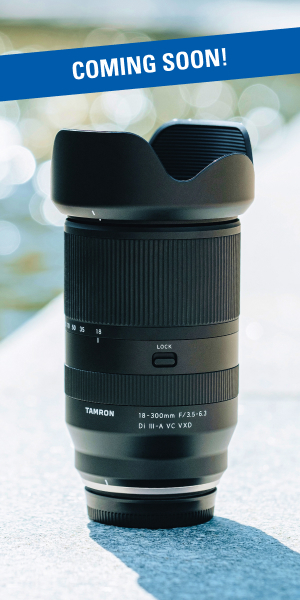Wildlife photography demands precision, patience, and the right equipment to capture the beauty of nature. With a Tamron telephoto zoom lens, you can get up close to distant wildlife without disturbing their natural behavior. In this post, we’ll share wildlife photography tips with telephoto lenses to help you maximize their performance and capture stunning images of animals in their natural habitats.
Getting started with wildlife photography begins with choosing the right lens, and Tamron offers some of the best telephoto lenses for wildlife photography to suit various shooting needs. The Tamron 150-500mm F/5-6.7 Di III VC VXD (Model A057) and SP 150-600mm F/5-6.3 Di VC USD G2 (Model A022) lenses provide exceptional reach, making them ideal for photographing birds, mammals, and more. If you need greater versatility, the 50-400mm F/4.5-6.3 Di III VC VXD (Model A067) lens delivers both standard and telephoto capabilities in one compact package. For those seeking a lightweight, budget-friendly option, the 70-300mm F/4.5-6.3 Di III RXD (Model A047) or 50-300mm F/4.5-6.3 Di III VC VXD (Model A069) lenses are great for casual wildlife encounters. Choosing the right gear sets the foundation for creating powerful, compelling wildlife compositions.
Images and Text by David Akoubian
What You’ll Learn In This Article:
- How to track birds in flight using effective autofocus zones
- Why eye contact and lighting elevate animal portraits
- When to photograph animals during their peak behavioral moments
- How to use environmental context to strengthen composition
- The best angles and perspectives for more engaging wildlife shots
TIP 1: Use Targeted Autofocus Zones for Birds in Flight

Capturing birds in motion is one of the most exhilarating—and challenging—aspects of wildlife photography with telephoto lenses. When photographing birds in flight, use an autofocus area mode that covers approximately 30% of your viewfinder. This gives your camera enough information to accurately lock focus on fast-moving subjects while avoiding background distractions.
Tamron’s telephoto lenses like the 150-500mm F/5-6.7 offer quick and reliable autofocus performance, essential for flight photography. For best results, set your AF to continuous mode and practice tracking techniques with local bird species.
Pro Tip: Pre-focus on a spot where birds are likely to fly through to increase your keeper rate.
TIP 2: Focus on Eye Contact to Create Connection

Great wildlife photos go beyond just documenting a subject—they create a connection. One of the most powerful ways to do this is by waiting until the animal makes eye contact or until light reflects in its eyes. This subtle moment brings life and intensity to your composition, especially when using Tamron’s telephoto zoom lenses, which allow you to maintain distance while still capturing detail.
Whether you’re using the 150-600mm or the 70-300mm, look for that catchlight in the eye, which adds depth and character to your wildlife portraits.
TIP 3: Photograph Wildlife During Peak Behavioral Moments

Timing is everything in telephoto wildlife photography. Photographing animals—especially males—during mating season often yields the most dynamic and expressive images. Subjects may display dominance, spar with rivals, or show vibrant seasonal features.
Use your Tamron 150-600mm or 150-500mm lens to observe safely from a distance without interfering. Wait for those key behaviors that define the animal’s role or season.
Pro Tip: Research your subject’s behavior beforehand to anticipate the best moments for storytelling through your images.
TIP 4: Zoom Out and Include the Environment

While it’s tempting to always fill the frame with your subject, sometimes the strongest wildlife images show animals within their environment. Pull back your zoom to provide context—show the animal’s terrain, weather conditions, or interaction with its surroundings.
Lenses like the Tamron 50-400mm and 70-300mm offer a flexible focal range that’s perfect for this kind of composition. Wide-to-telephoto versatility allows you to pivot between detail and landscape shots without changing lenses.
TIP 5: Shoot from a Lower Perspective for Intimacy

When photographing smaller wildlife like birds, positioning yourself at eye level or lower can dramatically improve your compositions. A lower angle adds intimacy and visual impact, making viewers feel immersed in the animal’s world.
The Tamron 150-500mm provides the reach to stay back while still achieving this low, personal viewpoint. Use a bean bag or ground pod for stabilization, especially when working near water or uneven terrain.
Pro Tip: A lower perspective reduces background clutter and improves separation between your subject and its surroundings.
Conclusion: Get Closer to Nature with the Right Tools and Techniques
Mastering our wildlife photography tips with telephoto lenses takes patience, practice, and the right equipment. Whether you’re photographing birds in flight or mammals in their environment, Tamron’s lineup of zoom lenses—including the 150-500mm, 150-600mm, and 50-400mm—offers the precision and flexibility to capture nature at its best.
By applying these field-tested tips, you’ll not only improve your technique but also create more compelling, professional-quality images. Explore Tamron’s full telephoto lineup and find the perfect lens for your next wildlife adventure—available through authorized Tamron dealers or directly at the Tamron Store.
More Photo Tips | Watch Videos | Learn More About Tamron Lenses | Photo Gallery
